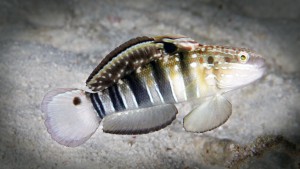Marine aquarists looking for a sand-sifting fish to keep the top layer of their sand bed stirred often run into a dilemma. Many of the species renowned for this behavior, such as the ever-popular and commonly offered yellowheaded sleeper goby (Valenciennea strigata), have the frustrating tendency of wiping out all the benthic invertebrates in the sand bed and then proceeding to starve to death because they don’t always learn to accept the non-living food items hobbyists offer.
One of the notable exceptions to this phenomenon is the brownbarred goby (Amblygobius phalaena), a.k.a. the bullet goby or sleeper banded goby. A. phalaena does a great job of sifting sand, but it’s much more inclined to accept standard non-living aquarium fare than V. strigata and many other sand-sifting species are.
Physical traits
A. phalaena is typically goby-shaped with a robust body, high-set eyes, and a comically oversized mouth. Though not the most chromatically blessed reef fish, it is an attractive species nonetheless, with yellow-greenish overall body color, five dark-brown bands along its flanks, and orange dots and white to bluish striations on its head. Size-wise, this goby can grow to approximately 6 inches in total length.
Feeding
A. phalaena feeds on tiny invertebrates, algae, and organic matter present in the substrate, which it takes up by the mouthful and expels through its gills. Thus, a well-established system with a bed of live sand—and possibly a refugium that houses healthy microfauna populations attached—is best for this species.
As alluded above, this omnivorous goby will also heartily accept small, non-living meaty items, such as mysid shrimp, enriched brine shrimp, and finely chopped seafoods. It will also accept—and should be offered—foods formulated for herbivores to satisfy its dietary need for algae. Multiple daily feedings are recommended.
Housing
Though the brownbarred goby is benthic and does not require a great deal of swimming room, it should be provided access to a decent-sized sand bed so it can exhibit its natural sifting behavior. I wouldn’t recommend keeping one in anything smaller than a 30-gallon tank. Also, be sure to cover the tank well, as this species is prone to jumping.
Compatibility
Relatively passive and prone to being bullied and stressed by more aggressive, boisterous species, A. phalaena should be kept only with peaceful, reserved tankmates. Conspecifics will tend to fight, so keep only one brownbarred goby to a tank unless you can acquire a known mated pair.
This species is generally considered reef safe. However, do be aware that sessile invertebrates positioned close to the substrate may be vulnerable to having sand drift onto their tissues as the goby sifts nearby.



